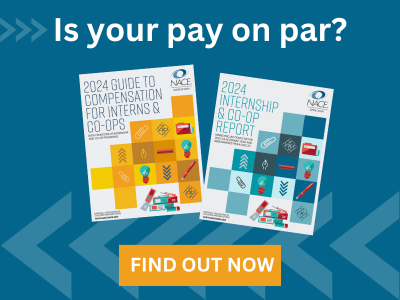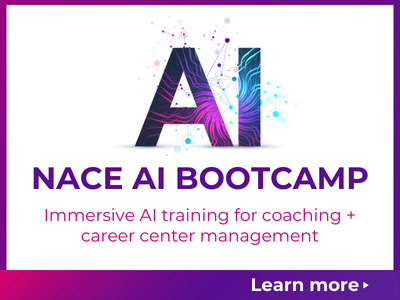NACE Journal, August 2020
There are only faint predictions as to what the post COVID-19 job market is going to be like. The economy has some of the highest unemployment rates since the Great Depression coupled with huge decreases in GDP. It is a sure bet that workplaces will be more distributed and virtual, at least for the foreseeable future. College campuses will likely be predominantly virtual as well, closed to in-person classes, with nearly all coursework online, and an increased number of both high school graduates and college students taking a gap-year to figure out their educational plans. Career centers, often already feeling understaffed, will likely be faced with resource cutbacks at a time when seniors especially (but the majority of students) will be even more desperate to find jobs. Traditional recruiting strategies with employers, such as on-campus career fairs and information sessions, will be essentially nonexistent.
The results from our survey conducted early this year—January through February 2020, prior to the coronavirus pandemic in the United States—offer some possible pivot points, some of which have probably already been implemented by foresighted career center professionals. For the record, here are some highlights of what we found in our nationwide online survey of 541 college seniors and recent graduates. (Note: Fifty-nine percent of respondents were men, and 22 percent were first-generation college students. Thirteen percent were attending or had attended a community college.) In this study, we focused on how students actually obtained internships. Our findings have clear implications for career center professionals moving forward.
Internships Have Many Benefits
Internships make college students more competitive in the job market because they give students a chance to gain knowledge, skills, and experience valued by potential employers. From a career development perspective, even more importantly, they provide an opportunity for students to see if the particular career field is the right one for them. Getting their feet wet, so to speak, affords them perspective about whether they could see themselves working full time (or even the rest of their lives) in this field. Even in the worst case, when students realize this is not the work they would want to do, they can still come away from the internships with their eyes opened to issues of organizational culture, politics, and leadership, and with lessons learned about the ropes to know and the hoops to jump through. Mentors may often be found during internships, providing invaluable advice in the job-search process, both internal to the internship employer and external. Finally, there are the real financial benefits associated with internships beyond summer employment. NACE surveys show that students who had internships were 20 percent more likely to receive full-time job offers than those without an internship. Having an internship also resulted in receiving significantly higher starting salaries.1
These facts are evident in these common refrains from corporate recruiters: “As a recruiter, I value students who have gotten great internship experiences over those [who] have not.” “A student who has an internship upon graduation will be more highly desired by employers than someone who did not venture into the ‘work world’ at all during college.” “Internships are imperative.”2
Nearly all of the employers responding to NACE’s 2019 Recruiting Benchmark Survey Report indicated that internships provide them with an important opportunity to identify talent early.3
Networking Is Key
Cold networking involves contacting someone without having any established or preexisting relationship versus warm networking, which involves making use of one’s network, e.g., family, friends, neighbors, teachers, and so forth, to make a connection between the applicant and the potential employer. While traditional wisdom has asserted that “who you know matters” and would seem to favor warm networking, our survey found just the opposite.
Somewhat initially surprising was the finding that students who engaged in cold networking were twice as likely to earn an internship as students who only engaged in warm networking. Moreover, those who found their internship through warm networking were less likely to report that the internship turned into a job offer. For those who reported that their internship resulted in a job offer, 70 percent found the internship through cold networking, while only 40 percent found the internship through warm networking. This finding suggests a possible intangible benefit of cold networking is that the internship may be perceived as earned on one’s merits rather than on riding the coattails of some personal relationship.
These trends continued to be evident for first-generation college students. First-generation student who engaged in cold networking were 38 percent more likely to earn an internship than first-generation students who did not similarly reach out. Moreover, first-generation students who did cold networking were four times more likely to have their internships turn into jobs than first-generation students who did not report doing cold networking.
Most students struggle with doubts about the significance of their accomplishments and have some sense of being exposed as a “fraud” or “imposter” related to reaching out and networking with business professionals.4 For first-generation students, imposter syndrome and insecurities are even more prevalent.5 Most students think to themselves, “No professional will want to meet with me” or “I might do something wrong and jeopardize future opportunities—it’s not worth it,” or “I’m not a good enough student to be worthy of a professional’s time,” and the like.
Networking makes a difference. In our study, more than nine out of 10 students who had an internship during college engaged in networking with business professionals via informational interviews. Students with two or more internships were eight times more likely to have conducted an informational interview. As Supreme Court Justice Sonia Sotomayor reflected on her own career: “Sometimes people are put off by the whole business of networking as something tainted by flattery and the pursuit of selfish advantage. But virtue in obscurity is awarded only in heaven. To succeed in the world, you have to be known by people.”6
An additional benefit from networking, as students reported in our survey, is that it increased their self-confidence. In support of the notion that “practice makes perfect,” we found that the more informational interviews students reported conducting, the higher the levels of confidence they reported in themselves, as reflected not only in obtaining an internship, but in their feelings of career readiness and skillfulness in networking. Low confidence levels in their networking skills were reported by 42 percent of those students who did not have an internship during college.
Teach Informational Interviewing
A constricted job market due to COVID-19 issues has many profound implications for students as well as college career professionals and corporate recruiters. While our survey was conducted before “the world/economy turned upside down,” the lessons are still applicable to helping students earn internships and jobs upon graduation/completion. Their chances increase when they can a) conduct informational interviews and b) use cold networking avenues. The imperative lesson is that, if students want to obtain internships and jobs, they need to conduct informational interviews, and the key to obtaining them is achieved through cold networking.
Career professionals need to engage with students to help them understand that “who you know” does not matter so much until “you know someone”! Moreover, the payoff from an internship appears to be greater (in terms of leading to a job offer) if it is obtained through cold networking rather than warm networking. This entails shifting from working with students to develop relationships with employers per se to teaching students how to network and conduct informational interviews, in the same sense as the proverb: “Give people a fish and you feed them for a day, but teach people how to fish and you feed them for a lifetime.”
Historically, four out of five jobs are not advertised7 and this hidden job market is likely to be even greater these days. Career professionals can make a concerted effort to teach students how to access those opportunities through cold networking. Doing so will improve the chances of students of not only gaining internships, but of securing full-time employment.
We can help students improve their confidence and ability to cold network by teaching strategies on how to most effectively conduct informational interviews. For example, in our study, we found that students who conducted informational interviews were considerably more likely to land an internship than those who relied on online job boards, career fairs, or information sessions. The massive switch to online classes has boosted students’ experience with digital connecting at the same time that employers have pivoted to virtual workplaces; this means that both parties should be increasingly confident in this medium for informational interviews.
Teaching students how to network creates a virtuous cycle. Each connection increases the likelihood of securing an internship (and finding employment). Most career centers were never meant to be in the job placement business and, during these very turbulent times both on and off campus, we must empower students to be proactive and even more accountable for their careers. The students generally have the will, and we need to make certain we are providing them with the skills and techniques to find their way.
Endnotes
1 National Association of Colleges and Employers (March 2016). “Paid interns/co-ops see greater offer rates and salary offers than their unpaid classmates.” www.naceweb.org/job-market/internships/paid-interns-co-ops-see-greater-offer-rates-and-salary-offers-than-their-unpaid-classmates/
2 Ibid.
3 National Association of Colleges and Employers (December 2019). 2019 Recruiting Benchmarks Survey Report.
4 Kolligan, J., & Sternberg, R. J. (1991). “Perceived fraudulence in young adults: Is there an ‘imposter syndrome’? Journal of Personality Assessment, 55(1), 308-326.
5 Canning, E. A., LaCrosse, J., & Kroeper, K. M. (2019). “Feeling like an imposter: The effect of perceived classroom competition on the daily psychological experiences of first-generation college students.” Social Psychological and Personality Science, 11(5), 647-657.
6 Sotomayor, S. (2014). My beloved world. New York: Vintage Books.
7 Burnett, B., & Evans, D. (2018). Designing your life: How to build a well-lived, joyful life. New York: Borzoi Book.



